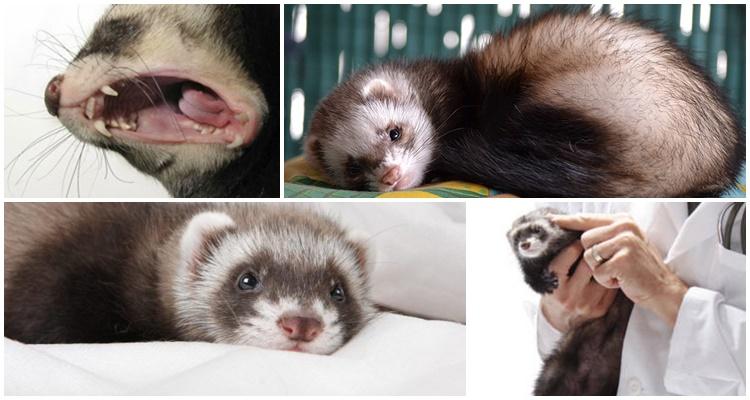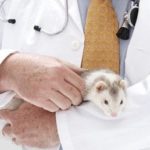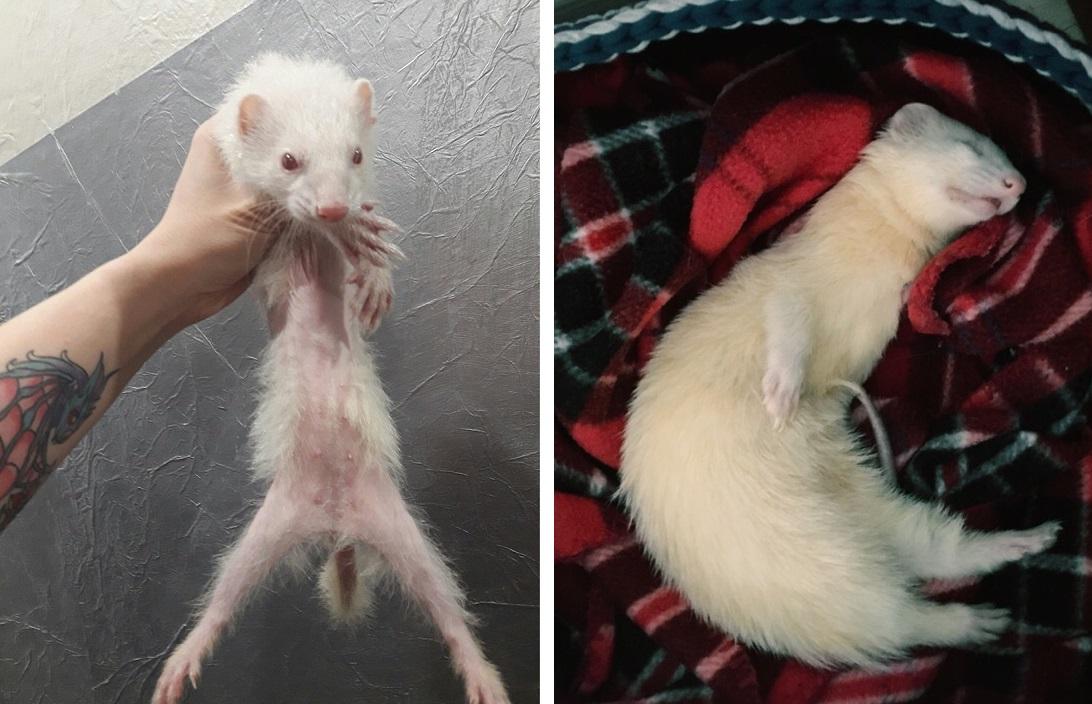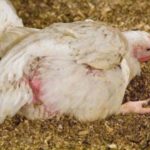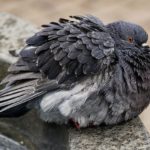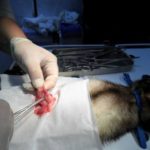Decorative ferrets are unpretentious pets; with proper care, they rarely get sick. Signs of a healthy animal are a wet and cold nose, a smooth and shiny coat, a lively look, active behavior, and a good appetite. The list of ferret diseases is wide, and many pathologies are fatal, so the owner who discovers symptoms in a pet should not delay contacting a veterinary clinic.
- Common Ferret Diseases and Treatments
- Rabies
- Aleutian disease
- Flu in ferrets
- Infectious diseases: tracheitis, bronchitis, adenovirus
- Inflammation of the paraanal glands
- Salmonellosis
- Leptospirosis
- Rickets
- Plague
- Anemia
- Gastroenteritis
- Cardiomyopathy
- Urolithiasis disease
- Diarrhea
- Stomach ulcer
- Cataract
- Pathologies of the endocrine system
- Stroke
- Tumors in ferrets
- Lymphoma
- Adrenal tumors
- Insulinoma
- Parasites
- Preventive actions
Common Ferret Diseases and Treatments
The body of ferrets is susceptible to many infectious and non-infectious diseases. The first group includes pathologies caused by viral and bacterial pathogens. Infections spread rapidly, affecting other domestic animals and humans. The second group of diseases is not dangerous to humans, but many pathologies are fatal, so you need to immediately take your pet to the veterinarian so that he can prescribe treatment.
Rabies
The infectious disease develops rapidly and is dangerous to humans. Incubation lasts 10-20 days. Symptoms of rabies in ferrets are pronounced:
- lethargy, problems with motor activity;
- temperature increase by 2-3 °C;
- excessive salivation;
- in some cases, vomiting, diarrhea;
- a gradual change in behavior, an increase in aggression, the desire to attack, bite;
- appearance of fear of water, refusal to drink;
- the desire to gnaw and swallow small objects;
- paralysis of swallowing muscles and limbs;
- in the last stage there are convulsions followed by death.
The only protection against infection is ferret vaccinationwhich must be carried out annually.
At the first symptoms of illness, the pet must be isolated and taken to a veterinary clinic for a blood test. If rabies is detected, the animal will have to be euthanized. The owner who has come into contact with an infected pet will have to undergo a course of vaccinations.
Aleutian disease
Also called plasmacytosis, it is caused by parvovirus. Death occurs from severe exhaustion, and in the acute form of the disease it is sudden. In the chronic form, the following are noted:
- temperature increase to 40-42 °C;
- depressed state;
- anemia;
- ulceration of the oral mucosa with bleeding.
Ferrets are treated at home with antibiotics, additionally given vitamins, probiotics, injections of glucose solution, and transferred to a therapeutic diet.
Flu in ferrets
Animals become infected with the influenza virus from a person or other animal. Typical symptoms:
- temperature increase;
- cough;
- copious nasal discharge;
- lacrimation;
- in some cases, violation of defecation;
- poor appetite;
- drowsiness, sedentary state.
The ferrets' body usually copes with the infection on its own, and the disease lasts up to 2 weeks. Young animals suffer the virus more severely and often require medical assistance. Medicines and dosage are prescribed by a veterinarian, but even timely therapy often does not save a young pet from death. To treat ferrets for any infectious disease, the antibiotic Gentomycin should absolutely not be used. It leads to kidney failure and deafness.
Infectious diseases: tracheitis, bronchitis, adenovirus
All of these diseases are caused by a viral infection, and all of them cause an increase in body temperature. With tracheitis and bronchitis, an intense cough with gagging and heavy breathing are noted. Adenovirus is accompanied by nasal discharge, chest wheezing, inflammation of the pharynx, and diarrhea.
Inflammation of the paraanal glands
In animals, the glands are cleansed during defecation and during active body movements. But with frequent constipation and diarrhea, they become clogged, causing them to become inflamed and ulcerated. Symptoms of the disease in ferrets:
- anal itching;
- swelling of the anal area;
- temperature increase;
- purulent discharge.
At the initial symptoms of the disease, the veterinarian cleans out the glands manually. Prescribes injections of an anti-inflammatory drug, and, if necessary, antibiotics. In advanced cases, the paraanal glands have to be surgically removed.
Salmonellosis
Animals under 2 months of age are most susceptible to infectious disease. Recovered pets become carriers of salmonella. In acute cases, more than 50% of ferrets die within 2 weeks. Before this, the following symptoms are observed:
- depressed, lethargic state;
- temperature increase to 40-42 °C;
- poor appetite;
- diarrhea;
- lacrimation.
Atypical salmonellosis is observed in adult ferrets; they lose their appetite and become exhausted. In a chronic course, accompanied by weakness, anemia, diarrhea, conjunctivitis, matting of fur, the animals die within a month. Ferrets are treated with antibiotics, probiotics, and antiseptic drops are dropped into the eyes.
Leptospirosis
With infectious jaundice, ferrets lose their appetite, the mucous membranes become yellow, and the lymph nodes swell. In acute cases, the temperature reaches 41 °C, convulsions, vomiting, and diarrhea are noted.
The sick pet is undergoing hospital treatment and is being given medication through IV drips.
Rickets
Skeletal development disorders are associated with a deficiency of calciferol (vitamin D) in the body. Symptoms of the disease in ferrets:
- depressed look;
- retardation in physical development;
- diarrhea, bloating;
- deformed limbs, curved spinal column.
For treatment, the diet includes small portions of cottage cheese, vitamin and mineral supplements and fish oil (3-4 drops per day). On warm days, the pet is walked in the fresh air.
Plague
The deadly virus in ferrets multiplies in the lungs and digestive tract. There is no therapy, death is inevitable, so the animal is euthanized so that it does not suffer. Plague is spread by birds, rodents, and even some types of insects. Therefore, the pet must be protected from contact with wild animals.
Incubation lasts 1-3 weeks. Symptoms of the disease in ferrets:
- temperature increase;
- conjunctivitis with greenish-yellow pus;
- loss of appetite;
- redness of the skin of the lower part of the muzzle, lips, anus with further formation of a crust;
- profuse purulent discharge from the nose;
- vomit;
- weight loss.
The only protective measure for domestic ferrets is annual vaccination.
Anemia
The disease is detected in female ferrets that are unable to mate. Excessive synthesis of estrogen leads to continuous estrus. As a result, disorders begin in the bone marrow and the production of blood cells stops. Gradually, secondary pathologies are added to anemia, accompanied by increased temperature, decreased appetite, and sometimes baldness.
The pet dies from bleeding due to a lack of red blood cells. To prevent this, the female must be periodically mated with a male, and if breeding is not planned, then sterilized.
Gastroenteritis
Infectious inflammation of the stomach leads to excessive secretion and bleeding, the animal's digestion is disrupted, and the body does not receive enough fluid and nutrients. The pet is treated by administering saline and glucose solutions and daily fasting.
Cardiomyopathy
Disorders of the heart muscle have been observed in ferrets from 4 years of age.With hypertrophic changes, the heart expands, fluid accumulates in the lungs, and breathing becomes heavier. With restrictive changes, the ventricular walls become denser, there are no symptoms, and the animal dies quickly. For treatment, medications are used to dilate blood vessels, restore normal blood pressure, and remove fluid (diuretics). The dosage is determined by the veterinarian.
Urolithiasis disease
In ferrets, urolithiasis occurs due to excessive consumption of plant food, infections of the urinary organs, and hereditary predisposition.
Symptoms of urolithiasis in ferrets:
- frequent but difficult urination;
- unnatural color and intense specific odor of urine;
- the presence of blood and grains of sand in the urine.
When the disease is advanced, grains of sand clog the passage of the ureter. The pet becomes depressed, falls into a coma, and dies. The veterinarian cleanses the urinary tract of grains of sand with an antiseptic under anesthesia. Next, he prescribes antibiotics and a therapeutic diet containing a minimum of plant food. To restore water balance and eliminate symptoms of intoxication, IVs are placed. Prescribes an ultrasound and urine test to check the condition of the animal.
Diarrhea
In ferrets, diarrhea is a symptom of both infection (plague, Aleutian disease) and disorders of the digestive tract (gastritis, colitis, peptic ulcer). Diarrhea is accompanied by infection of the intestines by tapeworms when a pet eats infected raw fish. To make an accurate diagnosis, you must contact a veterinary clinic a maximum of 10 days after the onset of defecation disorders.
Stomach ulcer
Bacterial infection actively multiplies on the stomach walls with an unbalanced diet and regular stress. When the disease is advanced, the pet dies due to extensive bleeding. Symptoms of the disease in ferrets appear gradually:
- first grinding teeth;
- then darkening of feces due to mixing with blood;
- diarrhea and vomiting.
At the initial stage of the disease, antibiotics and enzymes are used. The pet will have to follow a therapeutic diet for the rest of its life. If bleeding occurs, the veterinarian performs emergency surgery.
Cataract
Cloudiness of the lens, leading to blindness, occurs either due to a hereditary predisposition or due to a lack of vitamins A and E in the diet. A sign of the disease is the appearance of a pale blue eyesore. Treatment is surgical, but it is not used for ferrets. The animal can easily live half-blind, you just need to make sure that complications do not appear - glaucoma, uveitis. Uveitis is treated with topical application of 1% prednisolone acetate twice daily.
Pathologies of the endocrine system
Due to disruption of the adrenal glands in ferrets, the synthesis of corticosteroids, hormones that control metabolic reactions, is reduced. Symptoms of endocrine disorders in ferrets:
- depressed, apathetic state;
- loss of appetite;
- inadequate, fearful reaction to external stimuli.
Medicines are prescribed only by a veterinarian.
Stroke
When blood clots clog the vessels of the brain, the animal experiences convulsive seizures and possible loss of consciousness or orientation in space. A common symptom is paralysis of one side of the muzzle or torso. The animal may move in circles and bow its head unnaturally. The veterinarian prescribes anti-inflammatory steroids for paralysis.To recover, the animal needs good care, warmth, and plenty of fluids.
Tumors in ferrets
Tumors are often detected in older ferrets. Only a veterinarian can detect the disease, which is why preventive examinations are so important.
Lymphoma
Oncological disease develops slowly, accompanied by lethargy, loss of appetite, loss of body weight, and enlarged lymph nodes. In young ferrets, lymphoma develops quickly, is more difficult to cure, in most cases ends in death, and is accompanied by severe symptoms - coughing, heavy breathing, vomiting, diarrhea. For treatment, corticosteroids and chemotherapy are used.
Adrenal tumors
They can be malignant or benign and are associated with excess hormonal synthesis. Symptoms:
- dystrophic changes in the body;
- protrusion of bones;
- partial baldness;
- difficulty emptying the bladder in males.
Adrenal tumors in ferrets are surgically removed.
Insulinoma
The disease in ferrets is associated with low blood sugar. The pet becomes weaker, does not move its hind limbs, and fixes its gaze on one point. He salivates profusely and his chewing function is impaired. Before death, the animal falls into a coma.
For treatment, Prednisolone is used, and the pet is put on a therapeutic diet. Sometimes surgery is necessary.
Parasites
The most common diseases that attack ferrets are fleas and ear mites. With their vital activity, parasites cause unbearable itching. Due to constant scratching, wounds appear on the skin, into which bacterial infection can penetrate. When mites multiply, dark, foul-smelling discharge flows out of the ears profusely.
Fleas that actively reproduce in the warmer months can carry helminths and also provoke an allergic reaction in the animal, accompanied by baldness.
The first thing to do is contact your veterinarian to take a scraping and check for the presence of a tick. Pet stores sell a wide range of medications for fleas and ticks; it is most convenient to use drops for the ears and on the withers.
Preventive actions
To reduce the likelihood of developing diseases, it is necessary to provide your pet with optimal living conditions. Prevention includes:
- maintaining cleanliness in the cage, regular disinfection of the premises, processing of equipment and utensils;
- regular bathing of the animal using zoo shampoo;
- ensuring a balanced diet, including vitamin and mineral supplements in the diet to strengthen the immune system, maintaining the health of the skeleton and internal organs;
- annual vaccination.
At the first symptoms, you should take your pet to a veterinarian rather than treating it yourself. With inept manipulations and incorrect medications, the owner will only harm the pet and hasten death.

